field notes
turkey, 2011
I had never shot as many landscape photos as during this my first trip to Turkey. Landscapes aren't normally the main subject of my photographic interest, but this time I made an exception — for the scenic places I visited and because of lack of time for wildlife photography. This wasn't a surprise nor a disappointment because I had planned this trip so. Actually, I had never thought I would ever go to this country till a friend who is also a photographer invited me to visit him at the place where he lives in Alanya. So my first, and now maybe not the last, trip to Turkey was to Mediterranean coast and to Cappadocia — a region famous for its montane landscapes.
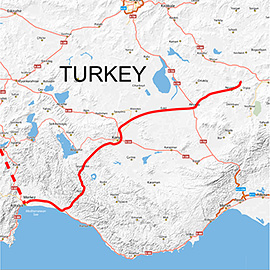
planning and preparation
Compared to other regions of the world that I either had already travelled to or was planning to visit, Turkey had never been really attracting me. I knew about the nature of this part of Asia in general. Of course, the fauna and flora there are more rich than at my home in Central Europe but they appeared to me by far not as rich and interesting as even in a neighbour country of Turkey — Iran. Turkey is very densely populated and has a strong and rapidly growing economy based on agriculture and tourism. The extensive use of land throughout the country led to destruction of most natural habitats in coastal areas and elsewhere in regions that are suitable for agriculture or touristic resorts. This was always my image of Turkey (which has proved to be correct during this trip) and hence I had never thought I would spend money and time to travel there when better alternatives are so countless.
After a friend of mine had set off to Turkey and stated urging me to visit him, I thought: Why not? Turkey is geographically very close to Europe, and since it is a popular holiday destination, it is easy to get there any time from the nearest airport. I decided to travel in early spring for several reasons. First of all, I expected fewer tourists in the view field of my camera when it isn't a high season. Second, I hoped that the prices for flight, accommodation and food would be lower. Third, the landscapes should look better because of frequent clouds at the sky, flowers and fresh green vegetation. March and April — the months that I chose for this travel are the beginning of breeding time for many animals. Some of them are more active and look more colourful.
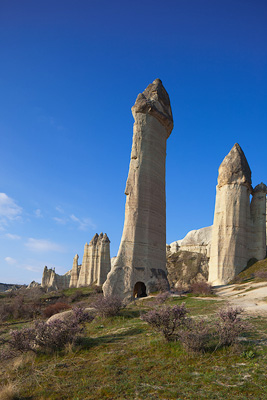
When I first saw a scenery like this one on a photo, I became curious about the place where it had been taken. So I learned about Cappadocia. (Click to enlarge.)
Cappadocia is probably the best known nature site in Turkey, therefore I decided to visit it first. It was also because I wasn't planning to come to this country again. So I thought that, if it should be only one trip, it had do be to a place that is an international hit. Though it is often photographed, among the images of Cappadocia that I saw during my research of information about Turkey only quite few were good. The most photos were either made by people visiting touristic attractions or for the purposes of advertising the tourism to Turkey. They were showing all the same views at the same locations. I thought that if Cappadocia is a quite large region, it should be offering more. However, I wasn't expecting to find much wildlife in the spring at so high altitudes. Thus, I decided to focus on photography of landscapes and to try to find alternative views and locations that are less known to public. To have enough time, I planned to spend five days there.
Since I was also going to visit a friend in Alanya, my second travel destination was the Mediterranean coast in province Antalya. This area is probably the most heavily suffering from economic activity of man in this country. However, outside of tourist season, it offers nice landscapes. However, the main reason for me to visit this area was its reptiles and amphibians. The herpetofauna of this part of Turkey is quite rich, particularly compared to Germany. Therefore my plan was to photograph herps while staying in Alanya for the second week of this journey. The book "Die Amphibien und Reptilien der Südwest-Türkei" by M. Franzen, M. Bußmann, Th. Kordges and B. Thismeier served me very well as main information source about distribution and habitats of amphibians and reptiles in this region of Turkey.
costs
In 2011, the overall expenses of a 14-days trip to Turkey such as mine did not exceed 1000-1200€ if you were travelling alone. This included return flight from Europe, staying in a 3-stars hotel with breakfast, dinner in a midrange restaurant, beverages and snacks during the day, car rental, fuel, tips for hotel and restaurant personnel. If you were travelling together with another person and shared expenses, it could cost you even less — as little as 800€ for a 2 weeks trip!
A flight by Turkish Airways from Nuremberg, which is the next airport to my home, was already quite inexpensive compared to my usual flights to other continents and even not so far — to Kiev in Ukraine. However, booking a flight with a hotel for two weeks was even cheaper: I paid only 324€ per person for a 3-stars hotel with breakfast in Alanya and a flight to Antalya — including a transfer by bus from the airport to hotel and back to the airport (about 250km!)! If you are wondering why I found it amazingly cheap, please read my previous travel reports from other countries.
During the trip, the low prices in Turkey kept surprising me. For approximately 7€ I could get a great dinner in a good restaurant. Even if I paid for drinks another 3 euros, the 10€ total that I spend for a dinner in a restaurant would have been an absolutely impossible price even for many places in Africa, not to mention Europe. Cars that were only a couple of months old could be hired for only 20€ a day — with complete insurance and unlimited daily driving distance. Fuel was much more expensive than even in Germany which had a positive consequence, however: There were not so many cars on roads as in Europe. In two weeks I travelled about 2500km by car and spent about 300€ for benzine.
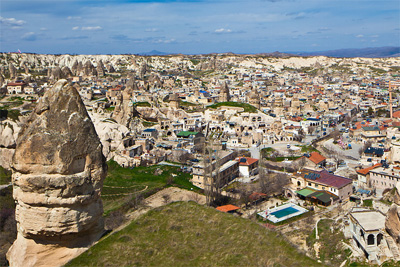
In Cappadocia I stayed in a small hotel in Göreme that is just inside the Göreme National Park. Göreme is officially a village but to me it looks more like a small town. Among such towns in this area it is the smallest but there are some smaller "real" villages too. Overall, there is too much population and too much economic infrastructure in this national park for the nature to be preserved. (Click to enlarge.)
Hotels in Turkey are not very cheap but somewhat cheaper than in Europe. I have no idea how much did the hotel in Alanya cost because I booked it together with flight. It had all comfort (even an electric hair drier in bathroom), but the breakfast was very poor and every day the same. In Göreme, the village in Cappadocia where I spent 6 nights, the hotel was very nice — but for the price of 35€ for a double room. A similar hotel in the German Alps would cost about the same money (see a report about my trip to Berchtesgaden). However, you can find hotels for 25€ or even less per double room in the same village. I had chosen this one only because I liked it more while the price wasn't really high.
At some touristically important places, such as Ihlara Valley or Side, visitors have to pay the entry. A day ticket costs between 4 and 7€. To increase the profit from tourism, the government is constantly developing further such places for visitors. The entry to many areas with ancient ruins is still free but this may change quickly. In Turkey, a nature or archeological site that has been made a touristic attraction usually looses its attractiveness for photographers because its natural and original look will be unavoidably destroyed by parking lots, shops, roads, and crowds of people. According to my observations, Turks usually don't care much about preservation of nature as such. If a place is scenic and looks attractive they would build in it recreation facilities and restaurants rather than attempt to preserve its natural state. Thus, the reason to avoid such places should be not the little money charged for the entry but the fact that the place itself is commercially overused and often absolutely uninteresting from photographic as well as from naturalist point of view.
the route and transportation
I took a direct tourist flight from Nuremberg to Antalya. A shuttle bus brought me from the airport to a hotel in Alanya where I spend two nights after arrival in Turkey. I reserved the first day for finding and hiring a suitable car. It was not difficult due to a great number of car rental companies and few tourists during this season. However, if you are going to rent a car in Turkey, you should do it with a reasonable amount of caution. In too many rental offices no car was immediately available though some cars were presented in front of the office as if they were for rent. I suppose that such companies had either no or too few own cars and needed time to get a car for me from someone else. Therefore, they either ask you to come back later or say that they will call you as soon as the car is ready. It is better not to accept this and to look for an immediately available offer. If you decide to wait, they may finally call you later and tell that they are sorry but the car isn't available. You only loose time in such a case. It may also happen that they bring you a car which you wouldn't want to take. It is better to check the car before you sign a contract and pay. This is possible only if the car is already available.
Turkey has a very good network of roads. All important roads are in excellent condition even compared to the streets in some Eastern European cities. Some country roads may be bad but still passable by a normal city car, i.e. unless you are going to drive really off-road, you don't need a 4WD in this country. I hired a completely new (built 2011) Renault Symbol for 12 days, and it served me all this time without any serious technical issues. For someone who is going to drive mainly on country roads, a little better alternative could be a Suzuki Jimny — a small 4WD car — which was available for 30-35€ per day.
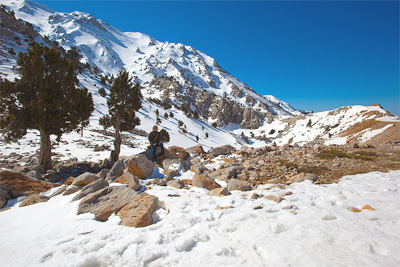
In just 1.5 hours of drive from the warm Mediterranean coast to the mountains there was much snow. Even if you stay in a hotel at the coast but have a car, it is possible to make day excursions to this snowy landscape. You will be amazed by the contrast between two kinds of climate. (Click to enlarge.)
The journey started on the second day when I went to Göreme in Cappadocia — a place more than 700km away from Alanya. Initially I reserved the whole day for the drive and started quite early in the morning — 6.30 a.m. — because I didn't know the condition of the road and how long the way will take. However, I arrived much sooner than expected — already at about 2.30 p.m. at the destination though I had made three breaks — to rest and to take photos. The way back took even less.
It is very easy to drive a car in Turkey. Normally you don't even need a map because directions and city names are shown on the shields everywhere. However, it may be quite difficult to find the way in cities because shields with street names are often completely absent. Anyway I didn't notice any in most places I've been to. A GPS navigation that I always was carrying with me helped me many times in such situations.
If you have been driving cars only in Western Europe or in the US, you may be surprised by quite different habits of Turkish drivers. They usually drive at least 20km/h faster than allowed, may change direction without any warning, quite often drive on red light, or someone may be driving very slow on the leftmost lane because he is talking on a mobile phone... If you drive a car in Turkey, just be careful and watch out for a strange behaviour of other drivers. Very soon I got used to it and was even enjoying such a different style of driving.
Between Manavgat and Konya this road is very scenic. Quite soon after the car ascended the mountains the temperature dropped and there was much snow at both sides of the road. I was impressed by this change between Mediterranean and highland climate within only two hours of drive. As the road was descending the landscape gradually changed to montane plains.
After my return to the coast, I spent 6 days in the Mediterranean region looking for reptiles in their habitats around Alanya.
photographic experience
cappadocia
Cappadocia is a region in Central Anatolia which is world famous for its ancient cave houses and churches that people made in lava rocks in 4-5 centuries AD. The UNESCO declared a quite large part of it a "world heritage". However, being there I had an impression that this status is used more to intensify tourism than for protection of natural or historical monuments. As everywhere in Turkey, the nature in Cappadocia is viewed by people only as something that should be useful and bring profit. With exception of so-called "open-air museums", I haven't seen any obvious results of attempts to protect the unique natural and historical landscape. Even in the part of Cappadocia that is supposed to be a national park no noticeable protection measures have been taken, and no activities of people appear to be restricted: Tramping, making roads, building houses, ploughing, pasturing, leaving wastes is either allowed or tolerated by the government. This causes serious problems for someone who has come to this place to photograph landscapes. The omnipresent, and often quite ugly, civilisation artefacts are not only frustrating, they also demand additional work from the photographer. You have to compose the frame more carefully, to avoid them or at least to reduce their presence in the picture. Therefore, you have not always the freedom to choose the scene you photograph. Quite often there would be a large ugly object, such as a barn with a blue or green plastic roof or a red and blue air balloon, in a picture of an otherwise beautiful landscape. I was considering two options then: to remove the disturbing object when I will be processing the image or to look for another subject.
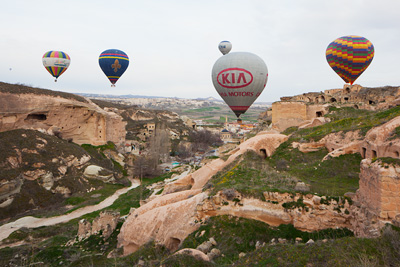
Air balloons flying tourists over Cappadocia. In the morning the sky was usually full of them, and then they often appeared in landscape shots. Sometimes it was quite irritating. (Click to enlarge.)
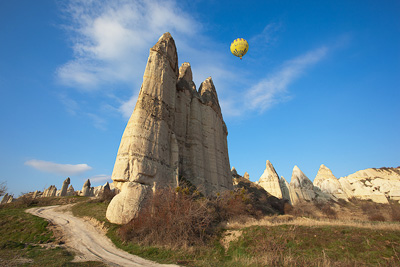
Air balloons were not always disturbing. Sometimes, like in this image, they were a nice detail. (Click to enlarge.)
With moving objects such as cars, people or air balloons I often was waiting till they left the scenery. When the light conditions were quickly changing it wasn't possible however.
Air balloons with tourists were flying only when the air was cold — between 6 and 10 a.m. Sometimes the sky was full of them but after 9 a.m. their number decreased significantly. In an image, if a balloon is disturbing the view, you can always clone it away because the surrounding pattern of pixels is quite simple — clouds or even the plain blue colour of the sky. However, sometimes a balloon flying in the sky can be a nice detail that you will want to keep.
There are countless photographic opportunities in Cappadocia. Unfortunately, I didn't see much wildlife but I had been expecting this and planned to do more landscape photography. Nevertheless, I was missing animals in those beautiful landscapes that I was photographing. To my surprise, even the bird fauna in Cappadocia was quite scarce: The most common birds were — like in European cities — house sparrows and domestic rock doves. I also was seeing quite many common starlings and black redstarts, i.e. bird species I frequently see at my home. I have to admit, however, that I wasn't really looking for birds because bird photography wasn't my goal this time.
As everywhere else, early morning and late afternoon were the best time for landscape photos. In Turkey you don't even need an alarm clock to get up early: a singing mullah will wake you up at 5.30 a.m. However, it is maybe better to get out of the bed earlier to be at the location at 6.00 a.m. when the morning light is the softest. At around 9.30 a.m. I returned to the hotel for breakfast.
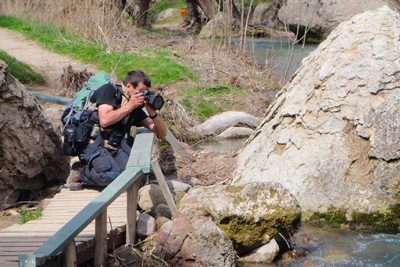
Ihlara Vadisi (Ihlara Valley) is a very beautiful canyon high in Taurus mountains. Unfortunately, it was made to an open-air museum because of its historical past: Christian refugees in early Middle Ages built there settlements. Now it is a popular recreation place both for Turkish and foreign tourists — with footways, bridges over the river and a couple of restaurants. Nevertheless, I'd recommend this location for landscape and bird photography. A day ticket costs about 7 €. (Click to enlarge.)
In the spring it was not hot during the day and I could continue shooting landscapes also after breakfast. The weather was also good for it: Though it wasn't raining, the sky was often overcast. I think the spring is a better season for landscape photography in Cappadocia than the summer because the sky is in the spring never completely cloudless. When I was there the sky was often blue during the day but with some clouds — a perfect combination for a landscape photo.
Also the time in the evening — till 8.00 p.m. — was very rewarding, i.e. till the sun was completely gone down.
I took both my cameras and all lenses with me on this trip. But since I was photographing mainly landscapes, I made the most shots with the full-frame EOS 5D Mark II and wide angle lenses — Carl Zeiss Distagon 3.5/18mm ZE and Canon TS-E 24mm f/3.5. In some situations I had wished even a wider or a narrower view angle. Thus, if you are going to Cappadocia, bring all your wide lenses — up to 35-40 mm. Certainly, you should also bring a tripod if you are serious about landscape photography: I made at least 80% of landscape photos with the camera mounted on Novoflex Quadropod. Flash can help sometimes to lighten up details in foreground: I was using an off-camera flash remotely controlled via Pocket Wizard.
antalya province
The nature in province Antalya probably suffers more than in any other region of Turkey from economic activities of the man. Sand dunes and strands have been made to beaches, golf fields and hotel resorts. Every year hundreds of new hotels, apartment houses and roads are constructed — to occupy more and more nature land. Due to this development, even endangered and worldwide protected sea turtles continue loosing their nesting sites... But who cares? Along the Mediterranean Sea coast no intact wildlife habitats are remaining any more. However, the economic use of this territory began, already in ancient times, and, although large animals became extinct in course of it, much of fauna and flora found ways to survive. Like in Europe, wildlife still persists either in places inaccessible for agriculture and building industry — such as steep mountain slopes — or has adapted to cultural land — such as plantations or historical ruins.
I had planned to focus on reptiles during my 6 days stay in Alanya. In fact, I could photograph only spur-thighed tortoises (Testudo graeca) and starred agamas (Laudakia stellio). I also saw some lacertids and scincids but couldn't achieve good images of them. They escaped in tall grass before I approached them with my camera at a distance of several meters. I wasn't surprised but regretting not to be technically prepared to deal with this problem. I didn't find any snakes nor chameleons though I was searching for them at remaining sand dune spots at the sea coast.
The above mentioned book by M.Franzen et al. provides quite precise information about habitats and locations in south-western Turkey where amphibians and reptiles can be found. I used it as a guide, when I was searching for these animals myself during this trip. It helped me to find the above mentioned species, and I explain my failure to find the rest through lack of time and my own field experience in Turkey. Anyway the description of habitats in the book matched perfectly what I saw myself.
I was very happy to learn that spur-thighed tortoises (Testudo graeca) are a so common reptile species in Turkey. During my excursions in Antalya Province, I was seeing them every day, and of course, I photographed everyone. Surprisingly, photographing a tortoise is not as easy as it may appear. In public, a tortoise has an image of a slowly-moving animal. This is not quite true. For their size and body shape, they can move quite quickly when the environment temperature is high. When a tortoise can't escape, it will hide its head and legs in the shell. If it happens, you will need to be very patient because you may wait long till the animal calms down. Because of that, a photo session with a tortoise took at least half an hour. Usually, I was using a wide angle lens (18 mm or 24 mm) for close-up shots — to capture an image of the tortoise in its environment. A couple of times I also used a 150 mm macro lens to make a shot from a distance when the tortoise was more relaxed and moving. However, it was quite difficult due to high and dense grass where the tortoise was trying to escape as soon as it felt that is was left alone. Unless you are interested in photographing parts of its body, such as head or legs, I would recommend to try shots with a wide angle lens from a distance of 25-40 cm. To do it, I took the tortoise and moved it to a place with little vegetation — to achieve a clear view at the subject. Of course, the tortoise pulled the head and the legs under the shell. How long it remained so was different with different individuals. It also depends very much on temperature and weather. On a hot day, the tortoise will very soon try to escape, while in the morning — when its body is cold — you may wait half an hour for the animal to become relaxed. As usually with such close-up shots at ground level I was using a flash whenever I had time to set it up. Flash was particularly useful when the day was sunny, and the sunlight was harsh. Though I had macro flashes, when I was photographing tortoises, I used a Sigma EF-530 DG Super flashgun with Lumiquest Midi Bouncer that I triggered via Pocket Wizard.
The spur-thighed tortoises spend the night in burrows which they make in the evening under bushes or large grass. In March-April, on sunny days, they were active from about 9.00-9.30 a.m. The time between 9.30 and 11.00 is the best for photographing tortoises as well as other reptiles in this season. This time extends when the sky is overcast. In later hours, when it is too warm and the sun is too bright, the reptiles were either too alert to be approached or even could not be discovered because they were hiding from the direct sunshine. From 5 p.m. on the tortoises were gradually disappearing in their burrows.
I found the spur-thighed tortoises at various arid locations overgrown with grass — ruin sites, mountain slopes, garden terraces. They are quite easy to discover, even if you aren't really looking for them. Normally, I just came across a tortoise when I was searching for other reptiles or for a view point to shoot a landscape.
Laudakia stellio — the Starred Agama — is another reptile species that I was glad to find in the Antalya Province. Photographing these lizards was an important part of my programme for this trip. The range of this agama species extends over much of the northern Mediterranean area of Europe. Although the population density is nowhere very high, this lizard is usually considered as not rare. I knew where to search for them in Turkey but was surprised that first could not find any. I had been expecting to see them frequently on stony slopes, ruins and walls — like other agamids and iguanids that I had seen in some other areas of the world. Also I was expecting that the starred agamas would appear already in the morning — like other lizards. To my great surprise, it didn't happen, and I wasn't able find them on the first days of my stay in Alanya despite extensive search. The success came only on the last day before departure: I found the agamas on the ancient ruins of Syedra. Then I knew why I couldn't find them before. The first reason was probably the too low temperature. To be active, these reptiles need a warmer environment. They start basking when the sun is high above horizon and the stones are already warm. So I assume that I had been trying to find agamas to early.
Second, the starred agamas were much shyer than I had initially thought. In the book by M.Franzen et al. I had read that they do not allow people to approach them closer than at 10 or even 20 metres but didn't take it literally. So, as with other agamids that I had seen previously (including the similar species — L. caucasia), I was looking for starred agamas much closer — probably too close to notice them before they noticed me and escaped. At least at locations that I visited one needs a telephoto lens with 500-600 mm or longer to photograph this species. I had to use a 2x extender with my 300 mm lens. Better results can be achieved when a lizard is caught and handled for a shot with a wide angle lens. I would try it anyway, if I come to Turkey again. This time I hadn't the necessary equipment.
The Mediterranean region has also wonderful landscapes. If you have no equipment for wildlife photography or are just a landscape photographer, you will still find many subjects. Of course, the landscapes there are spoilt by civilisation even much more than in Cappadocia but you can still find very scenic places. The best locations are in the Taurus Mountains. To get to a very beautiful place it should be enough just to take any road that goes away from the coast towards the mountains. If you are based in Alanya, I would recommend a very scenic road that starts and ends at the sea coast making a loop in the mountains. It can be found on a good map, or you can follow my description in the box below.
- From Alanya drive on the main road towards Antalya.
- Just after the tunnel — at Sarapşahan by Konakli — turn right and take the direction to Güzelbağ. Soon you will ascend to the mountains.
- After Güzelbağ head to Gündoğmuş.
- In Gündoğmuş take the road to Antalya (not to Alanya!), and at the village Geceleme you will finally reach the main road that goes from Antalya to Konya.
- On this road drive south towards Manavgat and Antalya (not north — to Konya!).
- Before you reach Manavgat turn left to Alanya (near Kizilağaç).
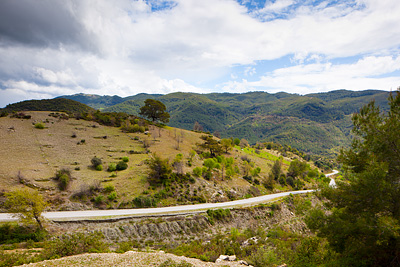
A road through the mountains via Güzelbağ and Gündoğmuş. At many parts it is very dangerous and can be passed only at very low speed. This road is very scenic and a landscape photographer wouldn't regret having had a day trip on it. (Click to enlarge.)
Driving on this road looks like a real adventure, and I wouldn't recommend it inexperienced drivers or anyone who suffers from acrophobia. Although the total distance of this road is not very long, at least 6 hours are necessary for it to be covered it by car. The road is not everywhere in good condition but can be passed by a normal city car. But don't even think about driving in bad weather! Parts of this road that go high in the mountains are quite dangerous: Stones can fall on the car; some stones are lying on the road, and you have to watch out for them; the road itself is partially destroyed or with deep pits... Many parts of the road are so narrow that only one car can pass, nevertheless the traffic in both directions is allowed, thus it is possible the a truck will be coming from the other direction when your car is already on that narrow part of the way while there is a steep mountain slope on one side of it and an abyss on the other. This is exactly what happened to me. Fortunately, there was still a very little space at the right side of the road, and I could drive aside and let the truck pass. Tooting for curves may help to prevent such encounters. I would highly recommend this road for its wonderful landscapes, but be careful when you drive! Reserve a whole day for this excursion and drive slowly.
Don't go to places advertised for tourists as nature sites because Turks usually mean a recreation park by that. The river Dim Çayı near Alanya is so. I went there in search of lizards Lacerta pamphilica whose habitat should be near its estuary according to the book that I had read. In Alanya hotels you may see advertising of this river as of a beautiful place where tourists can enjoy the nature. This isn't true because you won't see even its banks behind "aqua parks" and restaurants. There is a breeding site of sea turtles at its estuary. I didn't go there because it was a wrong season but if you happen to be there later in the summer this could be another place worth to visit. Of course, there are nice mountain slopes at both sides of Dim Çayı where Ottoman vipers (Montivipera xanthina) and other interesting species may live but as a landscape they offer nothing special.
If you happen to be in Alanya, it should be also a good idea to drive from the city to the east — towards Gazipaşa. The "all-included" Turkey ends very soon after you have left Alanya, and I was surprised by what I saw in Gazipaşa. Although this town is only in about half an hour of drive from Alanya there were no signs of tourism — no foreigners on the streets, no hotels, no shields in other languages than Turkish, people spoke only Turkish... It was a strange feeling to be quickly transferred to a completely different Turkey. The coast there is less suitable for beaches. This can prevent expansion of tourism further to the east from Alanya. I really hope so!
At about half the way between Alanya and Gazipaşa there is a quite large and beautiful ruin of an ancient town Selinus. You reach another one if you pass Gazipaşa by the road to Anamur — Antiocheia Ad Cragum — that seems to be of greater archeological interest but isn't as spectacular and attractive for a photographer. Ancient ruins in the Mediterranean region of Turkey are worth a separate mentioning. I explored 5 such sites:
- Side
- Alanya Castle
- Syedra
- Antiocheia Ad Cragum
- The Bath and the Odeion of Selinus
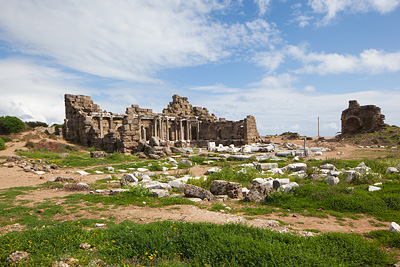
Due to its location between Alanya and Antalya, Side is a very popular touristic site. Thousands of people visit it every day. It was a large city in ancient times whose remains are now spread over many square kilometres. You have to pay the entry if you got to Colosseum or to museums, otherwise the visiting of the ruins is free. In spring there are not so many visitors and it should be possible to photograph flora and even landscapes. I can imagine that in main touristic season people would certainly appear in the view field too often and make it difficult. (Click to enlarge.)
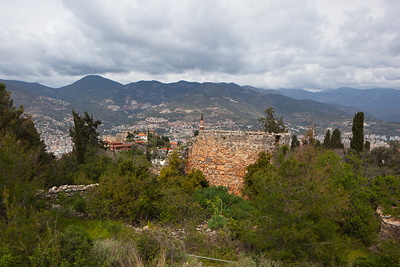
If you stay in Alanya, the Castle that you will see from almost every point in the city is certainly worth a visit. Although this historical site attracts many tourists, there are many quiet corners like in this photo — with beautiful flora, insects and even some reptiles. (Click to enlarge.)
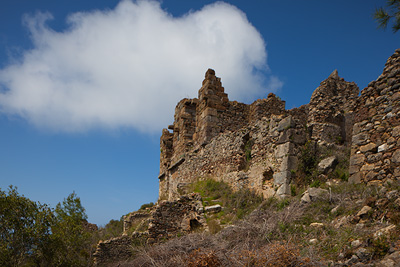
The ruins of Syedra. It is a large archeological site situated quite high in the mountains near Alanya. The mountains slopes and ancient walls are a habitat of Laudakia stellio, Chalcides ocellatus, Testudo graeca, Ophisops elegans and probably some other species of reptiles. I highly recommend this place to everyone interested in herpetology and reptile photography. (Click to enlarge.)
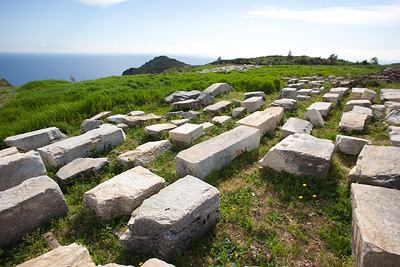
Antiocheia Ad Cragum was a large ancient city whose ruins are being excavated and researched by archeologists from a US university. In terms of landscape photography this place is not great but you can still find there some nice views as well a flora, birds, insects and reptiles. I was there in the afternoon when the light wasn't favourable. I'd recommend the photographers to come there in the morning when the cliffs are lit from the east. (Click to enlarge.)
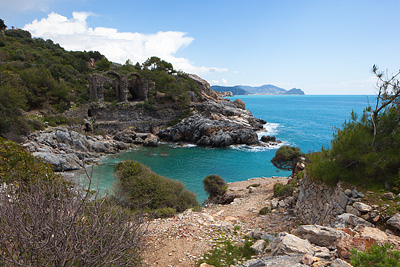
A view at the Bath of Selinus from the Odeion. This is an fantastic place. Selinus is a huge historical site that is still in a not-cultivated state that extends over a large area uphill. Unfortunately I had time only to explore this part at the sea. I would strongly recommend this place to everyone interested in nature and photography. (Click to enlarge.)
All of them are naturalistically and photographically quite interesting — though Side and Alanya Castle less than the rest because they are too popular as touristic attractions. I would recommend to visit all these places because flora and fauna are there better preserved than elsewhere at the coast. I went to Side in search for chameleons because this place is surrounded by dunes which are usually a habitat of Chamaeleo chamaeleon. Unfortunately, I didn't find any, and the dunes were heavily used commercially — as recreation place. Nevertheless, I could make nice photos of flora and landscapes at Side.
The Alanya Castle is the main historical monument in Alanya. It is a large fortress that was build in Middle Ages atop of a hill. Its entire wall, towers and many buildings inside it remained till now. The Castle is protected as a historical site and therefore is used only for tourism. Despite large numbers of people visiting it every day, there are many quiet places with beautiful Mediterranean flora. I found a tortoise on one of the slopes, but, of course, some other reptile species may leave there, too.
All other ruins that I visited during this trip were absolutely amazing places. They were in almost original state — like centuries ago, with no signs of commercial use. I don't think however that it will take long till these places get developed for tourism. Syedra will be the first due to its proximity to Alanya. A broad paved road to it is already being constructed, and a parking lot suitable for busses is ready. In Antiocheia Ad Cragum large scale archeological excavations are now running and disturbing the idyll of this otherwise quite remote and wild place. From the five ruin sites that I have visited only Selinus is still remaining untouched. This is particularly surprising because much of its ruins lie immediately at the road between Alanya and Gazipaşa. The fact that the still pristine ruin sites in Turkey are now facing forthcoming development for tourism is another reason why I strongly recommend nature photographs to visit them now.
general remarks
Although I hadn't been a big fan of this region, I am glad I had this trip. More than this: I would go to Turkey by the next occasion again. It is still not among my priority travel destinations but, if I will have time and some free money again, I would certainly do another such trip or two in the future.
If I would go to the same places again, it will be a little later — in late April. Winter could be also a very good season for landscape photography in Cappadocia.